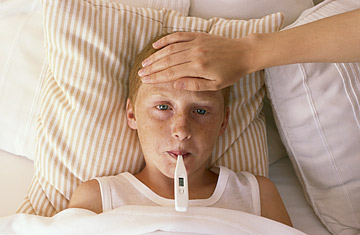
U.S. health officials are bracing for a resurgence of the new H1N1/09 flu virus this fall, when the influenza season kicks into high gear with the resurgence of cold weather. By October, the government hopes to have 120 million doses of vaccine ready to fight the new virus, which is currently spreading around the world in the first pandemic in more than 40 years. Already, H1N1 is hitting the southern hemisphere hard: Argentina has recorded more than 160 deaths from H1N1, second most after the U.S. That's because it's winter in the southern hemisphere, and flu infections tend to spike during the fall and winter months in temperate countries.
So why do infections tend to go up in the cold winter months and level off in the summer? According to a study from researchers at Mount Sinai Medical School, the flu virus is more stable and able to stay airborne longer when the air is cold and dry. The Mount Sinai researchers, who tested guinea pigs, found that the spread of the virus was most prevalent when the temperature reached a chilly 41°F (5°C); infections slowly decline as the mercury rises, before stopping altogether at 86°F (30°C). (Tropical countries, where fairly constant, high temperatures are prevalent, tend to have relatively even rates of infection all year long, without the sharp peaks and valleys seen in cooler countries.) It's also possible that the drier air in winter can dehydrate mucus in the nasal passages, lowering the body's natural defense against the virus.
But cold temperatures aren't the only reason for the fluctuations. Most of us spend less time in the sun during the winter, and that means we can end up vitamin D–deficient, leaving us vulnerable to any number of infections. And spending more time indoors can also put us in the line of infection for the flu, particularly if we share enclosed spaces with others. School is in session during the fall and winter in the northern hemisphere, and classrooms are excellent vectors of infection for all illnesses, including the flu.
Although so far the virus doesn't appear to have a significantly higher fatality rate than the usual seasonal flu, no one has immunity to the new strain — meaning we're likely to see very high infection rates. H1N1 is still spreading in the U.S., even during the summer — chiefly in summer camps and military installations, where young people are spending a lot of time in close contact. That alone shows just how transmissible this new virus is: we're dry kindling, and H1N1 is the match. But as with previous viruses in previous years, the real test for H1N1 — and for public-health officials who are planning their response to it — will come in the fall and winter.
